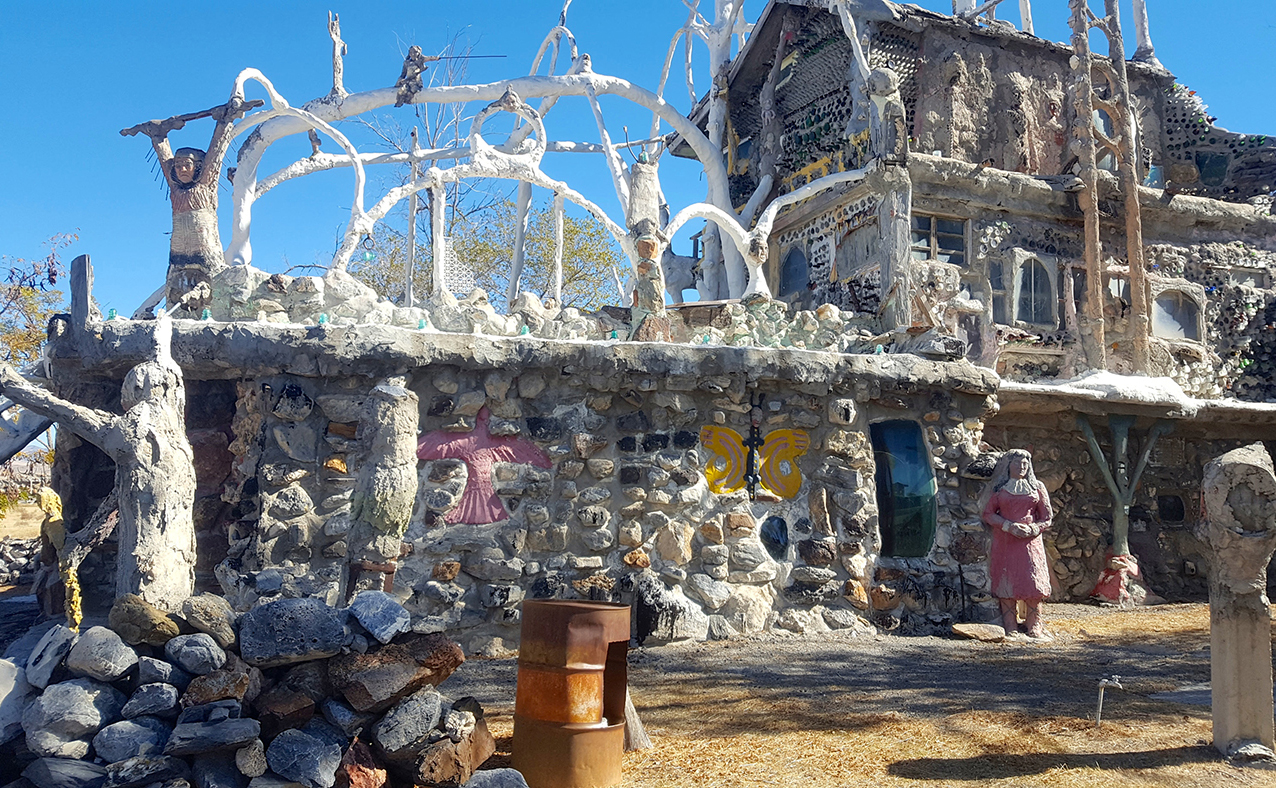An Uncanny Mountain Monument Is the Focus of an Outsider Artist for Half a Century - 5 minutes read
 An Uncanny Mountain Monument Is the Focus of an Outsider Artist for Half a Century
An Uncanny Mountain Monument Is the Focus of an Outsider Artist for Half a CenturyAs outsider art goes, you can’t get much further outside than Thunder Mountain Monument, built by Chief Rolling Mountain Thunder over many years, starting in 1969.
IMLAY, Nev. — The sign hanging from the fence outside the ostensibly unstaffed Thunder Mountain Monument, which sits along a lonely stretch of I-80 in northern Nevada, says, “ENTER AT YOUR OWN RISK.” Whether the main risk is stepping on a piece of broken glass or detritus from the salvage materials used to build the monument or having your soul claimed by any one of a dozen works of truly unsettling statuary, is unclear. As outsider art goes, you can’t get much further outside than this creation, built by Frank Van Zant over many years, starting in 1969.
Van Zant (1921-1989) was a World War II veteran and self-identified Creek Indian. Upon moving to Imlay, he experienced a vision that inspired him to take the moniker of Chief Rolling Mountain Thunder and begin building the monument. The footprint of Thunder Mountain includes a massive, ornate central structure, combining wattle and daub construction techniques, bottle walls, and other historical building methods. It is notable that there is no extant geological formation named Thunder Mountain, so the complex itself would seem to be the “mountain,” and Van Zant both its creator and caretaker.
Like everything in the complex, the main building — whose lofted archway is the most visible feature from the adjacent highway — is adorned with fragments of architectural salvage and repurposed refuse, and guarded by several statuary works. Some of these are modeled entirely from scratch, while others incorporate found materials that create a commentary on the ways in which American Indians have been displaced within colonial culture. Some of the statues seem to serve as makeshift sites of worship, with small offerings surrounding the feet of certain ones.
The three-tier central structure is now fenced off, but its base is apparently constructed around Mountain Thunder’s travel-trailer, which Van Zant covered with a combination of cement and mountain stones to serve as the foundation. Next, he began to surround the building with cement statues, including a monument to his son (one of eight children) who committed suicide. Others are dedicated to Mountain Thunder’s heroes, including Sarah Winnemucca, the Aztec god Quetzalcoatl, and Chief Standing Bear. Several of the works are self-portraits. An arch tops this central building, and serves as a metaphoric handle by which Mountain Thunder hoped the Great Spirit would carry away the monument, following the artist’s death.
The complete site covers roughly five acres along the south side of I-80. At one point it housed seven buildings, including a three-story hostel that became a destination point for spiritual seekers in the 1970s. Now, only three stone-and-concrete buildings remain, as well as the remnants of some damaged by a 1983 arson incident that partially destroyed the site, and some 200 concrete sculptures depicting Indians and their protective spirits, the massacres that devastated their people and nations, and other injustices against them. One imagines that it was an uncanny and powerful site, even at the height of its popularity: Mountain Thunder was named Nevada’s Artist of the Year in 1983. Now, with years of entropy and physical collapse creeping ever closer, it is downright forbidding. Rolling Mountain Thunder committed suicide in 1989, leaving the site in the care of his grown children. The area fell into neglect until it was declared a Nevada State Historic Site in 1992; it is now under the aegis of a State of Nevada Historic Site Restoration Project. A plaque at the entrance commemorates a William J. Schmidt, whose “generous donation” apparently facilitated a rehabilitation effort at the site in 2002.
Nonetheless, Thunder Mountain Monument is a lonely place, and one where the true isolation of an outsider artistic vision seems to radiate from the very soil. Thunder Mountain is one of those places where the boundary between art and ritual is exceedingly thin. As it represents one man’s struggle with his personal and cultural trauma, it retains a great deal of that energy, even in his absence.
Thunder Mountain Monument (800-804 E Star Peak Rd, Imlay, Nevada) is open to the public from 7am–7pm, seven days a week, for self-guided tours, by donation and at one’s own risk.
Source: Hyperallergic.com
Powered by NewsAPI.org
Keywords:
Outsider art • Outsider art • Thunder Mountain Monument • Imlay, Nevada • Nevada • Thunder Mountain Monument • Interstate 80 • Nevada • Detritus • Soul • Outsider art • Ronnie Van Zant • World War II • Thunder Mountain (1947 film) • Architectural engineering • Wattle and daub • Construction • Skill • Thunder Mountain (1947 film) • Van Zant • Architecture • Waste sorting • Found object • Native Americans in the United States • Colonialism • Culture • Travel trailer • Ronnie Van Zant • Cement • Cement • Suicide • Sarah Winnemucca • Aztec • Quetzalcoatl • Great Spirit • Interstate 80 • Dormitory • Arson • Nevada • Entropy • Suicide • Thunder Mountain Monument • Truth • Solitude • Thunder Mountain (1947 film) • Personal boundaries • Art • Ritual • Culture • Psychological trauma • Thunder Mountain Monument • Star Peak (Nevada) • Imlay, Nevada •